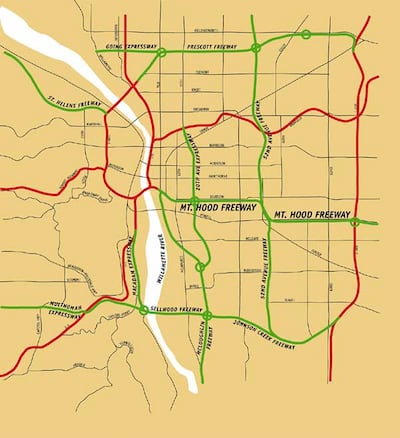Between the Interstate 5–Interstate 84 interchange and the Fremont Bridge, there are at least three unfinished freeway off-ramps that just end, dangling over the void. Was the Oregon Department of Transportation planning for off-ramps they couldn’t ultimately afford, or were the engineers just hoping to set Portland up as the scene of an epic Speed-inspired bus jump? —Jackie M.
There are certain questions I get asked over and over again. How can the Benson Bubbler water fountains be allowed to run constantly? Why are tens of thousands of crows gathering over downtown? What’s up with those ramps to nowhere?
Unfortunately, I answered all these questions years ago, which creates a dilemma. On the one hand, one hesitates to repeat oneself. On the other, most of the people who read the original 2011* column have probably died of old age by now, and there’s a whole new generation that deserves answers. Fortunately for your curiosity, Jackie, I have just enough new information on this subject to justify revisiting it.
Briefly, those ramps were designed to provide access to freeways that were never built. In 1943, Portland hired Robert Moses, the Darth Vader of New York City public works planning, to create an urban renewal plan for the city. His frankly bonkers scheme would have replaced Northeast and Southeast 20th Avenue, Northeast and Southeast 52nd Avenue, and Southeast Division Street (among others) with multilane expressways.

By the mid-1960s, these plans had been scaled back but still included a buttload of freeways. The ramps you describe would have joined up with the proposed Rose City Freeway. There would also have been a St. Helens Freeway and, most famously, a Mt. Hood Freeway, had they not all been defeated in the Great Portland Freeway Revolt of the 1970s.
The unelected Moses famously wielded more power in midcentury New York than mayors or governors, so there’s a certain irony that the man who finally pulled the plug on the Mt. Hood Freeway was another unelected power broker, Oregon Highway Commission chairman Glenn Jackson. (You may know his bridge.)
When Jackson finally withdrew his support for the freeway, effectively quashing it, he’s reported to have expressed his loss of faith in the project by saying, “I feel like we’re wiping our ass with a hook.” I’ve never been able to figure out what that means, but you have to admit it sounds pretty badass.
*This is not a joke; the previous ramp column was literally 14 years ago. Kill me.
Questions? Send them to dr.know@wweek.com.

